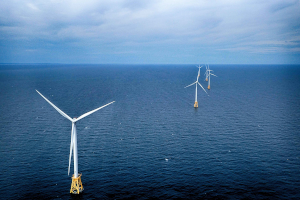 `
`
Contents
Offshore Renewable Energy refers to the generation of electricity from ocean-based resources. These include wind turbines located offshore in the oceans and Great Lakes and marine based energy sources including waves, tides, and salinity and thermal properties. Marine based projects are considered “offshore” if they employ ocean resources. For instance, a tidal generator located at a river’s mouth is considered offshore since it uses the flow of the ocean tides.
Maping Offshore and Coastal Electric Power
The National Ocean Economic program includes data on offshore electricity generation. Our data comes from public and private sources. More than half of the US population resides in coastal counties along with about 30% of its power generation facilities. Those powerplants generate 29% of all US electricity. At 60%, majority of power plants in coastal areas are gas fired with coal, nuclear, and oil plants providing another 20% of the electricity generated. The remainder consists of a diverse mix of renewable sources such as solar, biomass, hydroelectric, and waste heat form industrial sources.
Coastal counties in the US also tend to lead in Renewable Energy. They host more than half of the nation’s battery storage and a quarter of all utility scale solar power installations. However, coastal counites produce only 7% of the nation’s wind. This is set to change as the Biden Administration has prioritized the development of the nation’s offshore wind resources. An estimated 2,058 GW of energy lies off US shores, equating to 9,284 TWh. Currently, only a two offshore wind projects have become operations. These are the Block Island off the Rhode Island shore and the other at Coastal Virginia Offshore Wind Pilot situated twenty-seven miles off Virginia Beach. However, the Bureau of Ocean Energy Management (BOEM) currently has 2,732 square miles actively leased or set aside for research in renewable energy. Offshore renewable energy will contribute an ever greater share the nation’s energy in the coming years. NOEP will offer a variety of data on coastal and offshore power generation to track the impact of established and emerging power industries.
Offshore Renewable Energy refers to the generation of electricity from ocean-based resources. These include wind turbines located offshore in the oceans and Great Lakes and marine based energy sources including waves, tides, and salinity and thermal properties. Marine based projects are considered offshore if they employ ocean resources. For instance, a tidal generator located at a river's mouth is considered offshore since it uses the flow of the ocean tides. Currently, offshore wind technology has become mature enough to support utility scale power generation. Hydrokinetic technologies offer a great deal of promise, but largely remain under research. Globally, the amount of power generated by offshore wind has more than tripled. The United States lags behind, but as more of the leased sites this will change.
Conditions for Feasibility of Each Energy Type
| Resource | Water depth | Latitude | Avg. Speed | Other | Best U.S. Locations |
|---|---|---|---|---|---|
| Offshore Wind | Grounded: 0-80 meters Floating: 0-? meters |
7 meter/sec wind speed at 90 meters above sea level | Northern California Southern Oregon Northeast (NY-ME) | ||
| Wave | 40 meters | 30° - 60° | Off west coast of continents | Pacific Northwest Alaska | |
| Ocean Thermal Energy Conversion(OTEC) | > 1,000 meters | 0° - 35° | Surface water: > 25° C 20° difference in temperature surface water and extracted water | Hawaii Puerto Rico | |
| Current | Shallow water (0 — 30 meters) | Fast current speeds | Located at place of high marine flow* | Florida (Gulf Stream current) | |
| Tidal Range | Located at ocean inlet Tidal height range at inlet %gt; 7 meters | Washington state Alaska | |||
| Tidal Stream | 1.5 — 2 meter/sec water speed | Located at place of high marine flow* |
Offshore Wind
Offshore Wind is defined as wind turbines that are attached to the seabed or float in coastal waters (including the Great Lakes), and generate power from over-water winds. This resource is currently the most developed marine renewable energy technology. Globally, offshore wind produces in excess of 50,000 MW with17,399 MW having been brought online in 2021 alone.
Offshore wind turbines are similar in design to onshore turbines, but are larger in size and have a significantly higher capital cost because they need to endure harsh sea conditions and establish grid connections from out at sea. Their size and issues with connecting to onshore transmission lines result in much high capital costs. However, offshore wind turbines are more efficient and have a higher capacity factor as wind is stronger and more consistent on the ocean surface. With no impediments such as buildings and trees to divert wind flow, average capacity factor ranges from 18% to 54% onshore versus around 36% to 54% offshore Despite higher capital expenses, the Levelized Cost of Electricity for wind has fallen to an average of $84/MWh. This makes wind power generated offshore twice as expensive compared to that generated onshore. However, this is still cost competitive against power generated by fossil fuels. By 2030 the levelized cost offshore wind may fall as low as $60/MWh. As of 2023, the Energy Inforation Agency, reports that the average levelized cost of offshore wind has fallen to $84/(MWh) and can cost as little as $61/(MWh). This compares with a levelized cost of $32/MWh for onshore wind.
Offshore Wind Cumulative Installed Capacity Worldwide
Globally, over 50,263 MW of offshore wind power have been installed by 2021. Across the world, a multitude of projects are being planned which will bring worldwide wind power capacity to 369 GW with 286 of that scheduled to come on line by 2030.
The U.S. lags far behind offshore wind with only two operational windfarms, the Block Island Wind project and the Coastal Virginia Offshore Pilot. Together, these two installations provide 42 MW of power. However, the federal project pipeline for offshore wind promises to bring online and additional 40,083 MW in the coming years. In addition, states are creating policies which would produce an additional 39,322 MW in state waters. The Biden administration has also committed the US to develop a total of 30 GW of wind power offshore by 2030 with an ultimate goal of 110 GW by 2050.
The wind farms Cape Wind, Block Island, Bovoni 1 and 2, and Phase 1 of Atlantic City all share the same ambitious completion date of 2016 for their projects. Block Island wind farm, off the shores of Rhode Island, are on track to be the first offshore wind generating energy facility in the U.S. with 30 MW of power generation (The Boston Globe, 3/02/2015).
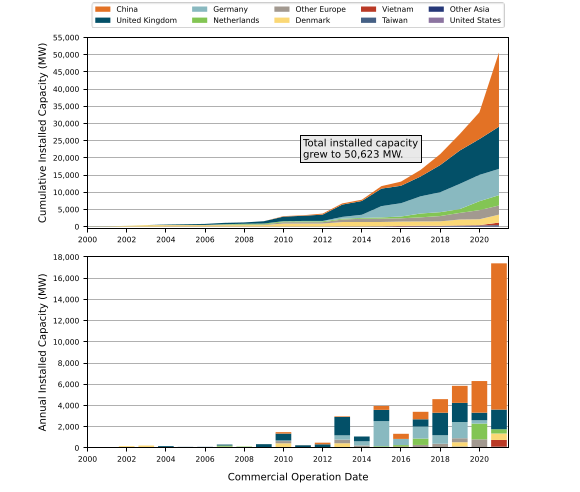
Hydrokinetic
Marine hydrokinetic energy refers to several developing technologies that are in various stages of research and development, all of which tap into the kinetic potential and movement of seawater to generate electricity. Hydrokinetic energy includes wave, tidal, and current energy. The untapped potential of hydrokinetic energy offshore in the U.S. represents half of all the power generated in the U.S. from other sources at 2,300 TWh/year.
Wave
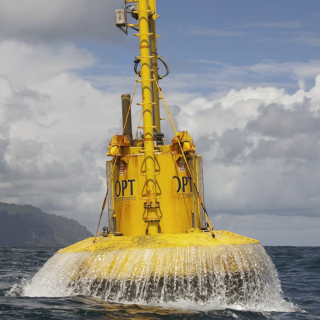
Wave energy uses Wave Energy Converters (WECs) to harness the potential of waves created when wind blows at the surface of the ocean. The amount of convertible energy depends on wind speed, duration, and fetch. Wave energy has been studied in academic settings since the 1970s. However, it remains a largely experimental energy source with only a single installation in commercial operation. This project is the CalWave X1 which was commissioned in 2021 off the California coast near San Diego. This pilot project generates 20 MW.
Tidal
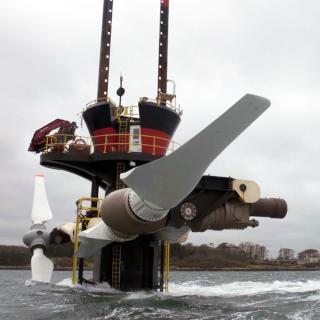
Tidal energy captures the potential energy in the daily variation in the tides. This energy source can be further broken down into tidal stream and tidal range. Tidal stream captures the potential hydrokinetic energy that exists from the horizontal ebb and flow of the tides. Tidal range captures the hydrokinetic energy that exists from the vertical rise and fall of the water column due to tides. Tidal stream, along with wave energy, is thought to have the highest commercial potential. There are major tidal streams along the coastline of every continent, giving it global viability, and has been garnering increasing interest from commercial operators and utilities. Tidal range is the only currently mature hydrokinetic energy source, with two existing large-scale projects in France and South Korea. However, tidal range also has more barriers to development, including limited potential project locations, high capital cost, and more environmental consequences than have been demonstrated by other alternative energy types.
Current
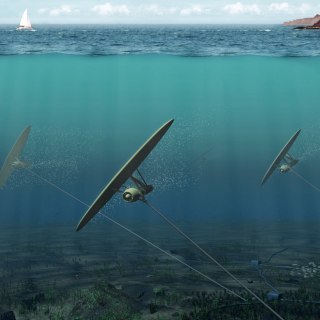
Current energy taps in to the conveyor belt of global ocean currents to generate electricity. This energy source is different from tidal range energy in that these currents are unidirectional, whereas tidal range captures temporary movement that can flow in two directions. Open ocean currents have the benefit of being a constant, reliable energy source, however, it tends to have slower velocities. If better technologies are developed that that successfully harness these slower velocities, current energy has potential for scaled up projects globally.
Costs and Impacts
Economic Costs
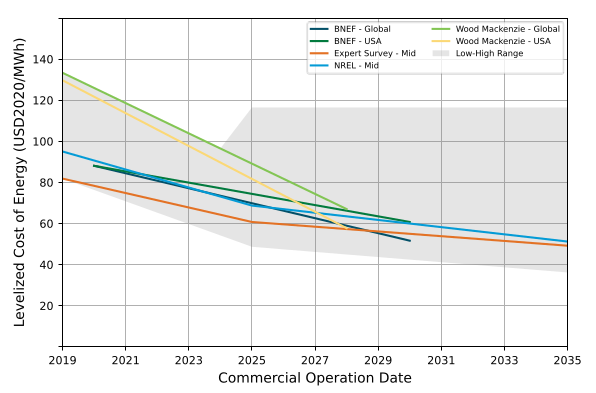
Renewable energy must compete economically with today's standard energy resources. One reason ocean energy is slow to develop in the United States is the associated comparative costs (Navigant 2014).
The charts on this page compare three economic variables that impact feasibility: the levelized cost of energy (LCOE), which is the cost to build and operate an energy generation device over its lifetime divided by the total power generated over its lifetime, the capital cost of energy, which is the start-up cost for a project, and the net capacity factor, which is the ratio of actual energy output in comparison to full potential of energy generated. The ideal energy resource has a low LCOE and capital cost and a high capacity factor.
New technologies characteristically have high costs and high variability of costs. As an industry advances, infrastructure and knowledge increase, and risk of investment becomes more advanced, driving the cost and cost variability down. Offshore renewable energy is characterized as a new energy type, and as such, the costs listed here are expected to decrease (Daniel et al. 2014).
The understanding of potential environmental impacts of offshore renewable energy is limited and highly dependant on the size, site, and technology type of the energy proposed. Assessing and planning based on environmental impact is another key consideration in offshore renewable energy development.
Search the TETHYS database for a repository of studies on environmental effects from offshore renewable energy. See below for a quick glimpse at potential environmental impacts.
Environmental Costs
The understanding of potential environmental impacts of offshore renewable energy is limited and highly dependant on the size, site, and technology type of the energy proposed. Assessing and planning based on environmental impact is another key consideration in offshore renewable energy development.
Search the TETHYS database for a repository of studies on environmental effects from offshore renewable energy. See below for a quick glimpse at potential environmental impacts.
| Resource | Element | Potential hazard | To lower risk... |
|---|---|---|---|
| Wind, Tidal, Current, Wave | Laying Cables | Disturbance, injury, and death of benthic habitat and creatures | Plan cable paths that minimize damage to significant benthic habitats |
| Wind, Tidal, Current, Wave | Underwater device installation | Disturbance, displacement, and death of benthic habitat and creatures | Avoid development on top of significant benthic habitats. Bonus: May act as an artificial reef, attracting the growth of plants and animals |
| Wind, Tidal, Current, Wave | Construction and maintenance | Noise pollution which affects animals' ability to hunt and mate | Minimize time taken and level of noise involved in maintenance |
| Tidal, Current, Wave | Oscillating energy devices | Disturbance, injury, or entrapment of marine mammals, large fish, and diving birds | Avoid development in ecological hotspots; develop technology to slow or shut down turbines when large animal is nearby |
| Tidal, Current | Underwater tidal turbines | Disturbance, collision, and death of marine mammals, large fish, and diving birds | Avoid development in ecological hotspots; develop technology to slow or shut down turbines when large animal is nearby |
| Wind | Turbine blades | Disturbance, collision, and death of birds | Avoid development along important bird migratory routes |
| Tidal | Tidal stream turbine arrays | Alterations in sediment and seabed morphology | Run tests before deployment— most sites are likely to have minimal change |
| Tidal | Tidal range barrage construction | Large-scale estuarine habitat alteration and species displacement | Add tidal range technology to outlets that contain preexisting infrastructure |
| Current | Ocean current energy devices | Disturbance and impediment of migratory routes of species | Avoid development in sections of significant migration; Opt for a location or depth that minimizes species traffic |
| Wave | Wave Energy Converters | Alteration of physical processes of waves near shore— sediment transport, beach building, etc. | Run site-specific simulations to examine impacts prior to installing wave energy converters |
